
The Toshiba EMI Recordings / U.S. Edition Series
#27 Yesterday And Today (AP-80061)
(Update: 21th. December 2024)

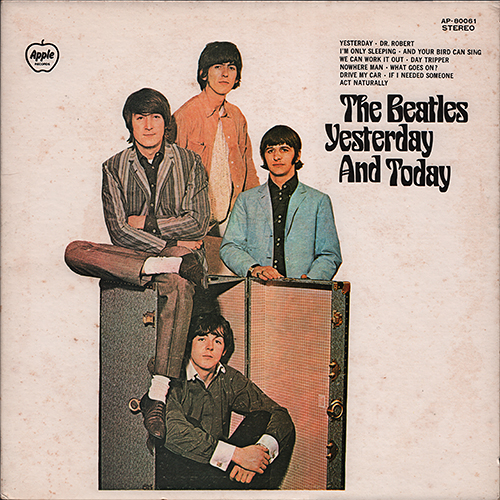 Apple 1st. Sleeve |
|
| TITLE | "YESTERDAY"... AND TODAY | ||||
| CATALOG NUMBER | AP-80061 |
||||
| RELEASE DATE | Test Press (First Press: 25th October.1970) | ||||
| TRACK LISTING | SIDE 1 | SIDE 2 | |||
| Drive My Car |
And Your Bird Can Sing |
||||
| I'm Only Sleeping |
If I Needed Someone |
||||
| Nowhere Man |
We Can Work It Out |
||||
| Dr. Robert |
What Goes On? |
||||
| Yesterday |
Day Tripper | ||||
| Act naturally | |||||
| FRONT --> Click! | BACK --> Click! | SIDE 1 --> Click! | SIDE 2 --> Click! | DISK --> Click! | |
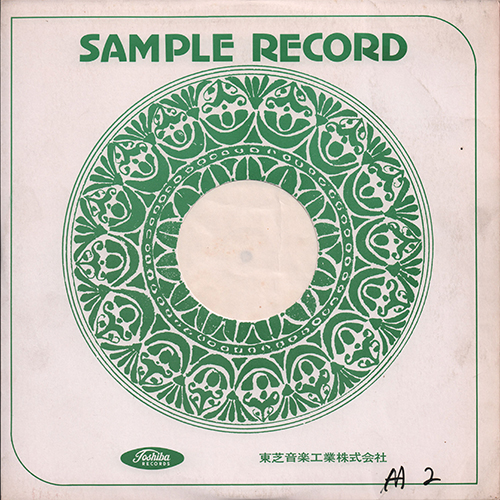 |
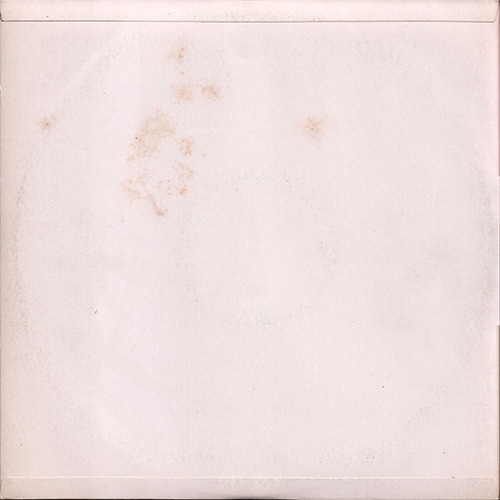 |
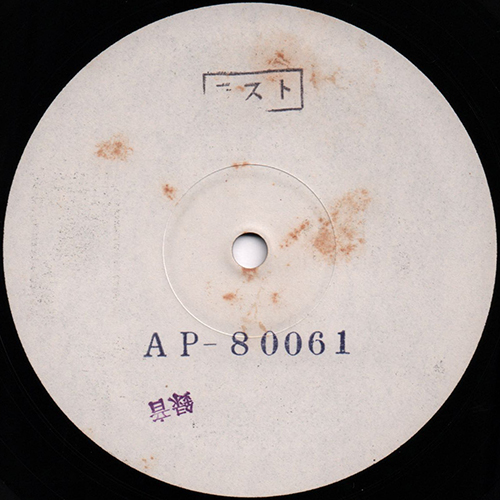 |
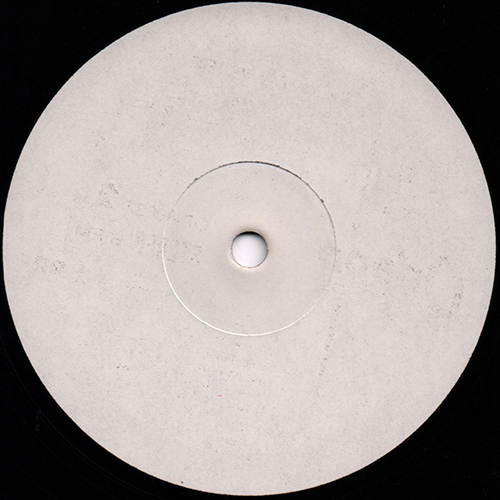 |
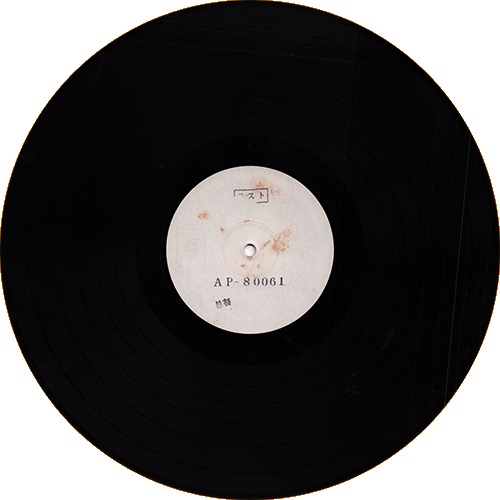 |
|
| INNER SLEEVE |
|||||
| FRONT --> Click! | BACK --> Click! | INSIDE: CLOSE UP | |||
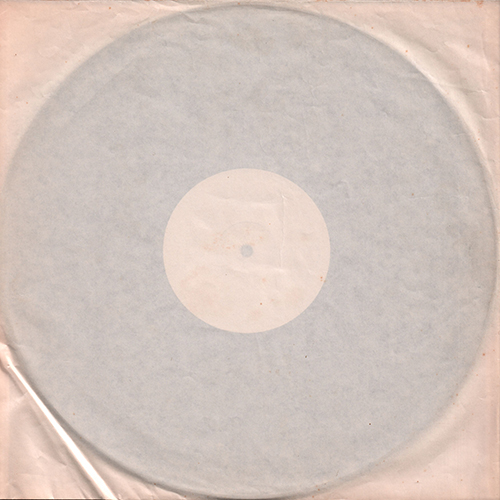 |
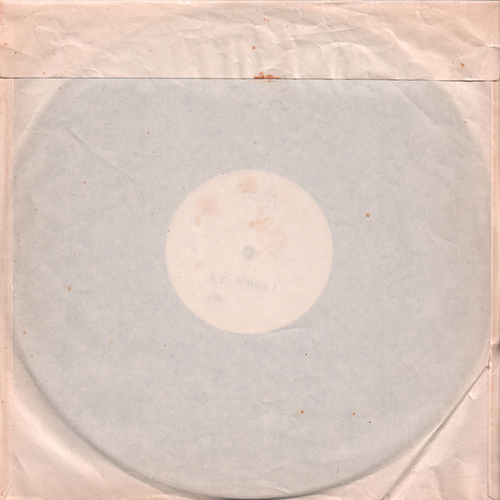 |
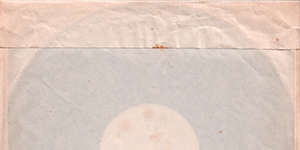 |
The original plain white inner bag has a
fold-over flap at the top of the bag to prevent the record
from falling out. |
||
| LYRIC
SHEET CLOSE UP |
|||||
 |
Test copies were sometimes sent in generic
Toshiba Sample Record covers. |
||||
 |
|||||
| LABEL CLOSE UP | |||||
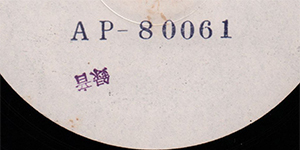 |
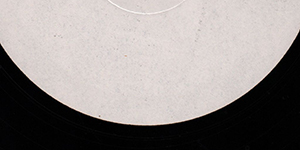 |
A blank version of the
Odeon promotional label was used for test pressing. The
catalog number "AP-800061" was and stamped at the bottom of
the label. |
|||
| LABEL CLOSE UP | |||||
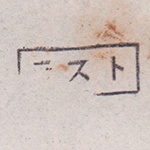 |
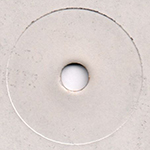 |
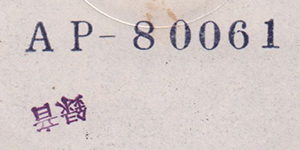 |
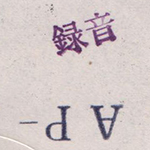 |
||
| Above the center hole, there is a stamp with the word "Test" in a square frame. | The label is stamped with the catalog number
and the word "recording" in kanji. |
||||
|
OTHER ITEM
|
|||||
| - | |||||
| RECORD LABEL | White label (Test press and promotional
use only) |
||||
| MIX | STEREO |
||||
| MATRIX No. | SIDE 1 | ST-X-1-2533
1S 1 |
|||
| SIDE 2 | ST-X-2-2533 1S 1 | ||||
| PRESS MARK | - |
||||
| VINYL COLOR | BLACK |
||||
| RECORD COMPANY'S NAME | SLEEVE | Toshiba Ongaku kogyo Kabusikigaisha |
|||
| LABEL | - |
||||
| SYMBOL/PRICE | - |
||||
| LYRIC SHEET STYLE | - |
||||
| COVER FORM | Toshiba Sample Record Sleeve |
||||
| INNER SLEEVE |
Plain White Inner bag |
||||
| OBI |
- | ||||
| COVER DESIGN/ PHOTO/ NOTES | - |
||||
|
COMMENTS
|
"Beatles Capitol
Original Album (AP-800XX)" is a series that introduces
American Capitol edited albums in the same format and songs
as at the time. Seven albums from "Meet The Beatles! (AP-80011)" to "Yesterday And Today (AP-80061)" were released in 1970. Test pressings are manufacturing samples intended to check the quality of a record before it is mass-producted. They are produced in very limited quantities and are very rare. They originally were not intended for public distribution. A blank version of the promotional label was used for test pressing. The catalog number "AP-80061" was and stamped in blue ink at the bottom of the label. The title was not written on the label. The test pressing was done on black vinyl. Test copies were sometimes sent in generic Toshiba Sample Record covers. |
||||
| TITLE | "YESTERDAY"... AND TODAY | ||||
| CATALOG NUMBER | AP-80061 |
||||
| RELEASE DATE | 25th October.1970 / CBS SONY Contract Press | ||||
| TRACK LISTING | SIDE 1 | SIDE 2 | |||
| Drive My Car |
And Your Bird Can Sing |
||||
| I'm Only Sleeping |
If I Needed Someone |
||||
| Nowhere Man |
We Can Work It Out |
||||
| Dr. Robert |
What Goes On? |
||||
| Yesterday |
Day Tripper | ||||
| Act naturally | |||||
| FRONT --> Click! | BACK --> Click! | SIDE 1 --> Click! | SIDE 2 --> Click! | DISK | |
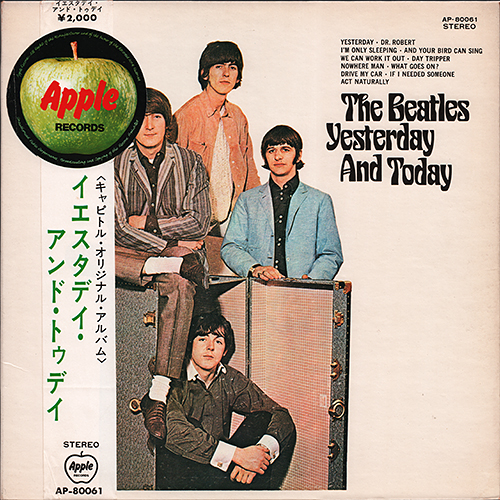 |
 |
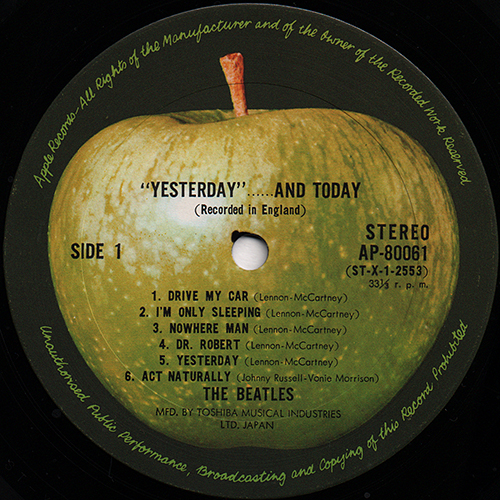 |
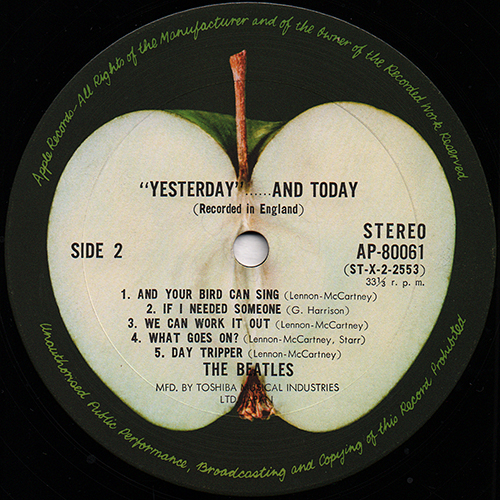 |
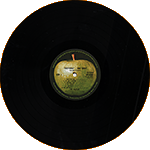 |
|
| INSIDE --> Click! | INSIDE: CLOSE UP |
||||
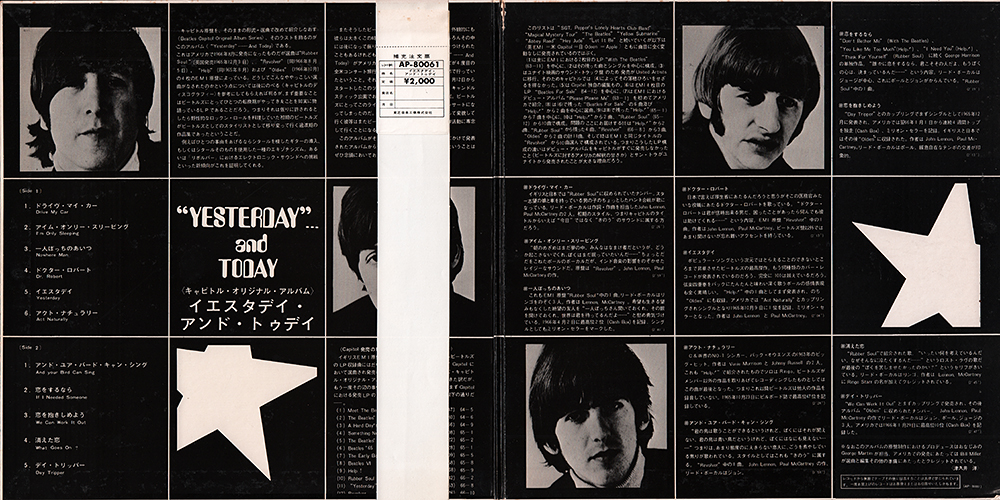 |
Same Trunk cover as U.S. press but with
gatefold jacket. Thick cover. |
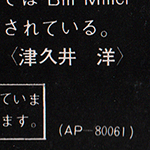 |
Liner notes: Hiroshi
Tsukui. Credited with liner notes on Japanese releases. |
||
| INNER SLEEVE | LYRIC SHEET (Slip Sheet Type) | ||||
| FRONT --> Click! | BACK --> Click! | FRONT --> Click! | BACK --> Click! | With
Apple
custom
black inner sleeve. The lyric sheet is slip sheet type. |
|
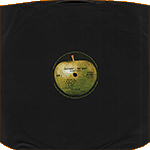 |
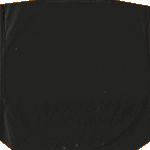 |
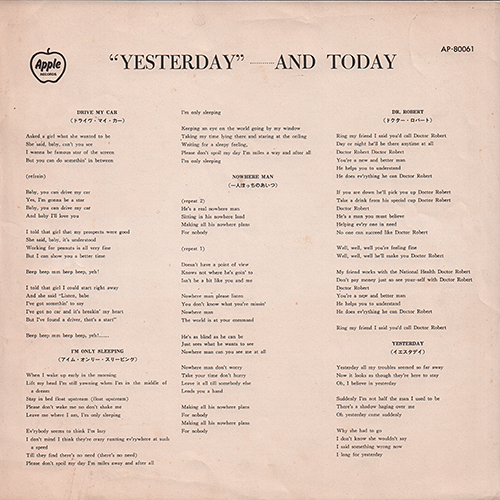 |
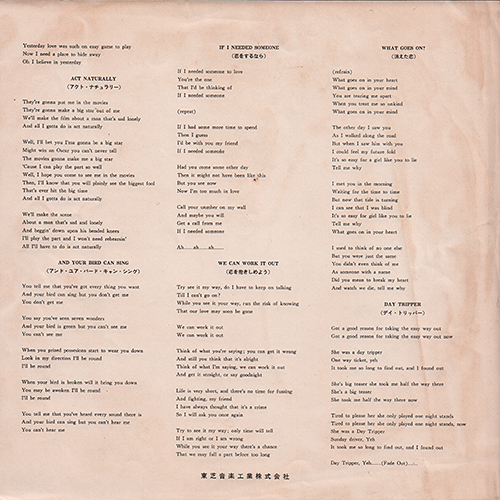 |
||
| LYRIC
SHEET
CLOSE UP |
|||||
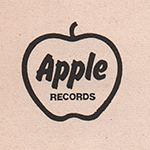 |
Apple logomark was printed at the upper left corner of the lyric sheet. |  |
 |
||
| Catalog No. and the company name "Toshiba Musical Industries Ltd." were printed on the lyric sheet. | |||||
| FRONT COVER CLOSE UP | BACK COVER CLOSE UP | ||||
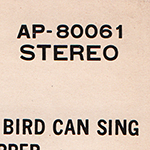 |
Catalogue number and "STEREO" were printed at the upper right corner of the front cover. | 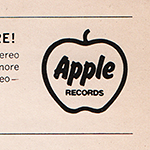 |
 |
||
| Apple logomark was printed at the upper right
corner of the back cover. "Toshiba Musical Industries Ltd." and "H ¥2,000" were printed at the bottom of the back cover. |
|||||
| BACK COVER CLOSE UP | |||||
 |
Capitol executive Dave Dexter Jr. was tabulated the choice and running order of the songs contained on all of the previous make-shift American Beatles albums, however, the project was turned over to another Capitol employee, Bill Miller, who ended up being credited on the album jacket. | ||||
| Apple Gourd in White OBI CLOSE UP | |||||
| OBI: FRONT | OBI: BACK | ||||
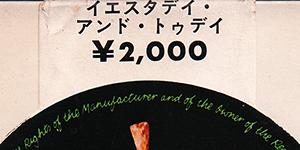 |
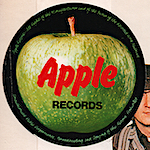 |
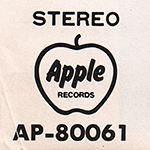 |
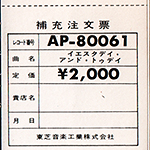 |
||
| Issued with a narrow Obi with a large round Apple logo at the top, has a white background. The word "STEREO" and Apple logo mark and catalog number "AP-80061" were printed on the front. 1st. pressing had a priced ¥2,000 on the obi strip. | Has a order sheet on the back side of the Obi. Catalog No, price "¥2,000" and "Toshiba Musical Industries Ltd."were printed at the order sheet. | ||||
| LABEL CLOSE UP | |||||
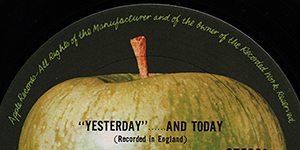 |
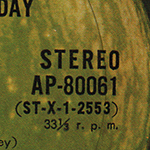 |
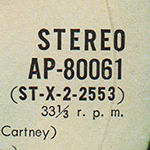 |
The phrase "Apple Records - All Rights of the Manufacturer and of the Owner of the Recorded work Reserved." was printed at the perimeter. "AP-80061" and matrix number were printed at the right side of the center hole. | ||
| LABEL CLOSE UP | |||||
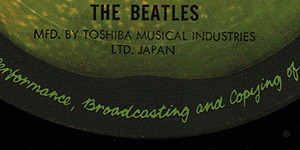 |
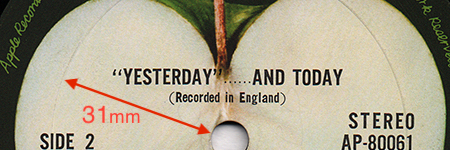 |
||||
| The words "MFD. BY TOSHIBA MUSICAL INDUSTRIES LTD. JAPAN" was printed at thebottom of the label. | Sometimes Toshiba had problems to press
enough records to keep up with the demand. To increase
production they turned to other companies (Gramophone, Sony
etc.) to press up some copies of a particular release. CBS Sony contract press: There is a ridge approximately 31mm out from the centre hole. Songs are from U.K. master tapes, different than USA pressings. |
||||
|
OTHER ITEM
|
|||||
| - | |||||
| RECORD LABEL | Dark Green Apple label Type-1 |
||||
| MIX | STEREO |
||||
| MATRIX No. | SIDE 1 | ST-X-1-2533
1S2
3 |
|||
| SIDE 2 | ST-X-2-2533 1S 2 | ||||
| PRESS MARK | F
S
9 |
||||
| VINYL COLOR | BLACK (CBS SONY Contract Press) |
||||
| RECORD COMPANY'S NAME | SLEEVE | Toshiba Ongaku kogyo Kabusikigaisha |
|||
| LABEL | MFD. BY
TOSHIBA MUSICAL INDUSTRIES LTD. JAPAN |
||||
| SYMBOL/PRICE | H ¥2,000 |
||||
| LYRIC SHEET STYLE | Slip Sheet Type |
||||
| COVER FORM | Gatefold Type. Thick cover. | ||||
| INNER SLEEVE |
Apple custom black sleeve |
||||
| OBI |
"Gourd" in white Obi (a narrow Obi with a large round Apple logo at the top) / with Order sheet | ||||
| COVER DESIGN/ PHOTO/ NOTES | Photo: Robert Whitaker Liner notes: Hiroshi Tsukui. |
||||
|
COMMENTS
|
"Beatles Capitol
Original Album (AP-800XX)" is a series that introduces
American Capitol edited albums in the same format and songs
as at the time. Seven albums from "Meet The Beatles! (AP-80011)" to "Yesterday And Today (AP-80061)" were released in 1970. Dark green Apple label Type-1with black print. Same Trunk cover as USA but with gatefold jacket. Songs are from U.K. master tapes, different than USA pressings. Black vinyl disc. Most if not all of the red vinyl OR and OP Odeon LPs were manufactured with an ingredient intended to prevent the buildup of static electricity on the disks. TOSHIBA's trademark for records manufactured with this ingredient is "Ever Clean", and special efforts were made to promote this feature. Sometimes Toshiba had problems to press enough records to keep up with the demand. To increase production they turned to other companies (Gramophone, Sony etc.) to press up some copies of a particular release, however, the majority of copies were pressed by Toshiba themselves. AP-80061 contract pressings: CBS SONY Contract Press PM=none There is a ridge approximately 31mm out from the centre hole (The diameter of the ridge is 69mm). The obi: Apple "Gourd" in white Obi 1st. pressing issued with a narrow Obi with a large round Apple logo at the top, has a white background. The word "STEREO" and Apple logo mark and catalog number "AP-8940" were printed on the front. 1st. pressing had a priced ¥2,000 on rear sleeve and obi strip. While most Japanese records feature local music, a lot of music fans there like foreign music, as well. The language barrier in Japan presented a problem – should foreign album covers be changed for Japanese albums? The solution was the obi, which means “belt” or “sash”. The obi is a strip of paper, usually about two inches wide, that wraps vertically around the album cover, containing information about the artist and album in Japanese. As these strips of paper were fragile and easily torn, they are often missing, especially since consumers in the 1950s and 1960s attached little significance to them. Finding Japanese records made prior to 1970 that still have the obi intact can be quite difficult, and for some albums, nearly impossible. The inclusion of the obi can dramatically affect the price of some Japanese records, sometimes increasing the price by a factor of ten. |
||||
| TITLE | "YESTERDAY"... AND TODAY | ||||
| CATALOG NUMBER | AP-80061 |
||||
| RELEASE DATE | December 1971? / 2nd. Press | ||||
| TRACK LISTING | SIDE 1 | SIDE 2 | |||
| Drive My Car |
And Your Bird Can Sing |
||||
| I'm Only Sleeping |
If I Needed Someone |
||||
| Nowhere Man |
We Can Work It Out |
||||
| Dr. Robert |
What Goes On? |
||||
| Yesterday |
Day Tripper | ||||
| Act naturally | |||||
| FRONT --> Click! | BACK --> Click! | SIDE 1 --> Click! | SIDE 2 --> Click! | DISK | |
 |
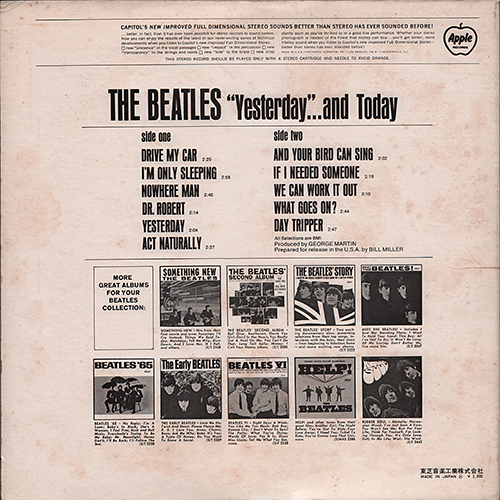 |
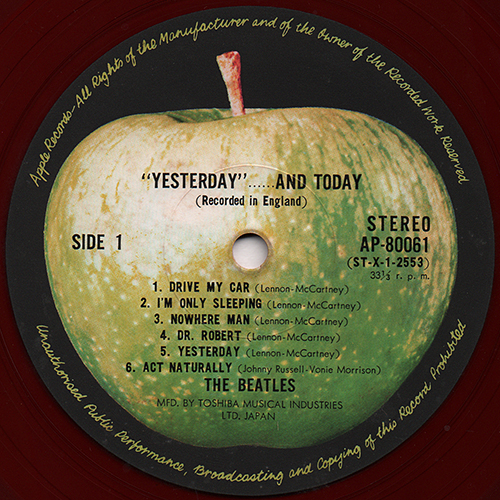 |
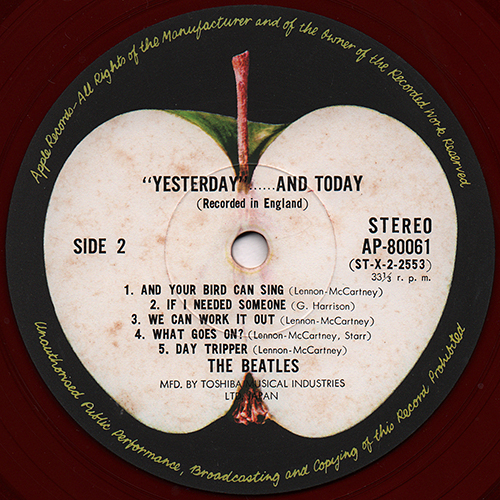 |
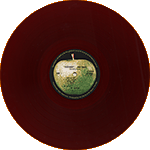 |
|
| INSIDE --> Click! | INSIDE: CLOSE UP |
||||
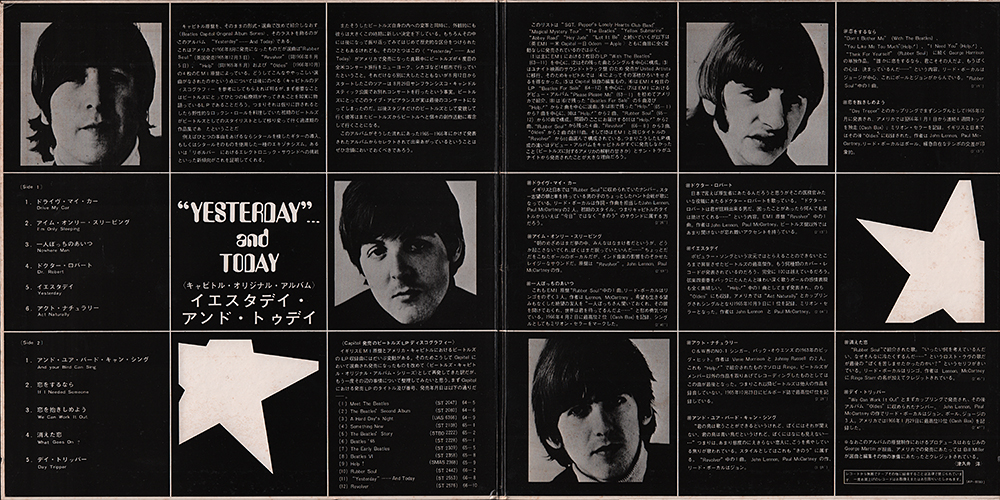 |
Same Trunk cover as U.S. press but with
gatefold jacket. Thick cover. |
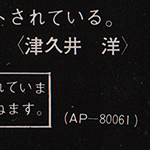 |
Liner notes: Hiroshi
Tsukui. Credited with liner notes on Japanese releases. |
||
| INSIDE CLOSE UP --> Click! | |||||
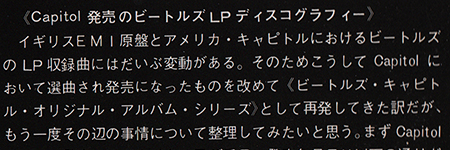 |
"Beatles Capitol Original Album (AP-800XX)" is
a series that introduces American Capitol edited albums in
the same format and songs as at the time. Seven albums from "Meet The Beatles! (AP-80011)" to "Yesterday And Today (AP-80061)" were released in 1970. |
||||
| INNER SLEEVE | LYRIC SHEET (Slip Sheet Type) | ||||
| FRONT --> Click! | BACK --> Click! | FRONT --> Click! | BACK --> Click! | With
Apple
custom black inner sleeve. The lyric sheet is slip sheet type. |
|
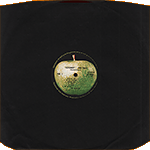 |
 |
 |
 |
||
| LYRIC
SHEET CLOSE UP |
|||||
 |
Apple logomark was printed at the upper left corner of the lyric sheet. |  |
 |
||
| Catalog No. and the company name "Toshiba Musical Industries Ltd." were printed on the lyric sheet. | |||||
| FRONT COVER CLOSE UP | BACK COVER CLOSE UP | ||||
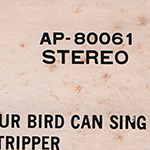 |
Catalogue number and "STEREO" were printed at the upper right corner of the front cover. | 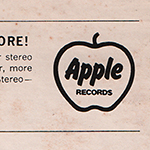 |
 |
||
| Apple logomark was printed at the upper right
corner of the back cover. "Toshiba Musical Industries Ltd." and "H ¥2,000" were printed at the bottom of the back cover. |
|||||
| BACK COVER CLOSE UP | |||||
 |
Capitol executive Dave Dexter Jr. was tabulated the choice and running order of the songs contained on all of the previous make-shift American Beatles albums, however, the project was turned over to another Capitol employee, Bill Miller, who ended up being credited on the album jacket. | ||||
| Apple Gourd in White OBI CLOSE UP | |||||
| Issued with a
narrow Obi with a large round Apple logo at the top, has a
white background. The word "STEREO" and Apple logo mark and catalog number "AP-80061" were printed on the front. 1st. pressing had a priced ¥2,000 on the obi strip. Has a order sheet on the back side of the Obi. Catalog No, price "¥2,000" and "Toshiba Musical Industries Ltd."were printed at the order sheet. (Sorry, I don't have it) |
|||||
| LABEL CLOSE UP | |||||
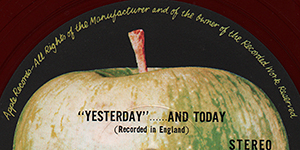 |
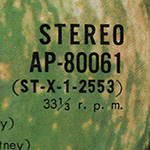 |
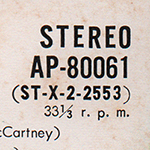 |
One of the primary
manufacturing companies in Japan, Toshiba, pressed a lot of
their records on red, “Everclean” vinyl from 1958 through
1974 (maybe). |
||
| LABEL CLOSE UP | |||||
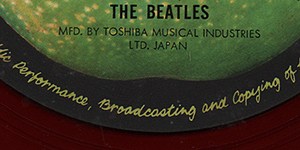 |
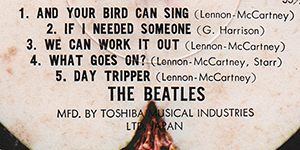 |
The words "MFD. BY TOSHIBA MUSICAL INDUSTRIES LTD. JAPAN" was printed at thebottom of the label. | |||
|
OTHER ITEM
|
|||||
| - | |||||
| RECORD LABEL | Light Green Apple label Type-2-1 |
||||
| MIX | STEREO |
||||
| MATRIX No. | SIDE 1 | ST-X-1-2533 1S2 13 | |||
| SIDE 2 | ST-X-2-2533 1S2 4 | ||||
| PRESS MARK | 1M |
||||
| VINYL COLOR | RED |
||||
| RECORD COMPANY'S NAME | SLEEVE | Toshiba Ongaku kogyo Kabusikigaisha |
|||
| LABEL | MFD. BY
TOSHIBA MUSICAL INDUSTRIES LTD. JAPAN |
||||
| SYMBOL/PRICE | H ¥2,000 |
||||
| LYRIC SHEET STYLE | Slip Sheet Type |
||||
| COVER FORM | Gatefold Type. Thick cover. | ||||
| INNER SLEEVE |
Apple custom black sleeve |
||||
| OBI |
"Gourd" in white Obi (a narrow Obi with a large round Apple logo at the top) / with Order sheet | ||||
| COVER DESIGN/ PHOTO/ NOTES | Photo: Robert Whitaker Liner notes: Hiroshi Tsukui. |
||||
|
COMMENTS
|
"Beatles Capitol
Original Album (AP-800XX)" is a series that introduces
American Capitol edited albums in the same format and songs
as at the time. Seven albums from "Meet The Beatles! (AP-80011)" to "Yesterday And Today (AP-80061)" were released in 1970. Light green Apple label Type-2-1with black print. Same Trunk cover as USA but with gatefold jacket. Songs are from U.K. master tapes, different than USA pressings. In Novemver 1968, that was the date when Apple Corp Ltd. of England and Toshiba came to an agreement on the manufacturing and distribution of the Beatles' records in Japan. As part of that agreement, Toshiba had to reissue on the Apple label all the records previously issued on the Odeon label.The sleeves also had to be altered to desplay the Apple logo. Futher still, all the Odeon catalog number prefixes were changed to ones With Apple prefixes.In most cases, only the prefixes were changed and the catalog numbers were left intanct.Odeon singles, EPs, and LPs with the OR or OP prefixes were changed to Apple singles, EPs, and LPs with the AR or AP prefixes , respectively. But Toshiba did not instantly implement all these changes and did not immediately withdraw all Odeon label records.In fact, the phasing out of the Odeon label products and the phasing in of the Apple label was a lengthy process taking several months at least. And in the Apple label, there are two subtypes, TOSHIBA MUSIC and TOSHIBA EMI. Further more, the early copies of the APPLE-TOSHIBA MUSIC type have dark Apple on its label, though the late copies have light one. Red vinyl: Besides good sound and quality printing, Japanese records also offered some other things of interest to the collector. One of the primary manufacturing companies in Japan, Toshiba, pressed a lot of their records on red, “Everclean” vinyl from 1958 through 1974 (maybe). While not pressed as collectors’ items, these red vinyl pressings are more sought out by collectors than their black vinyl counterparts. The Everclean vinyl was designed to be less prone to collecting static electricity and dust than the more common black vinyl. The obi: Apple "Gourd" in white Obi 1st. pressing issued with a narrow Obi with a large round Apple logo at the top, has a white background. The word "STEREO" and Apple logo mark and catalog number "AP-8940" were printed on the front. early pressing had a priced ¥2,000 on rear sleeve and obi strip. While most Japanese records feature local music, a lot of music fans there like foreign music, as well. The language barrier in Japan presented a problem – should foreign album covers be changed for Japanese albums? The solution was the obi, which means “belt” or “sash”. The obi is a strip of paper, usually about two inches wide, that wraps vertically around the album cover, containing information about the artist and album in Japanese. As these strips of paper were fragile and easily torn, they are often missing, especially since consumers in the 1950s and 1960s attached little significance to them. Finding Japanese records made prior to 1970 that still have the obi intact can be quite difficult, and for some albums, nearly impossible. The inclusion of the obi can dramatically affect the price of some Japanese records, sometimes increasing the price by a factor of ten. |
||||
| TITLE | "YESTERDAY"... AND TODAY | ||||
| CATALOG NUMBER | AP-80061 |
||||
| RELEASE DATE | January 1974? / 3rd. Press | ||||
| TRACK LISTING | SIDE 1 | SIDE 2 | |||
| Drive My Car |
And Your Bird Can Sing |
||||
| I'm Only Sleeping |
If I Needed Someone |
||||
| Nowhere Man |
We Can Work It Out |
||||
| Dr. Robert |
What Goes On? |
||||
| Yesterday |
Day Tripper | ||||
| Act naturally | |||||
| FRONT --> Click! | BACK --> Click! | SIDE 1 --> Click! | SIDE 2 --> Click! | DISK | |
 |
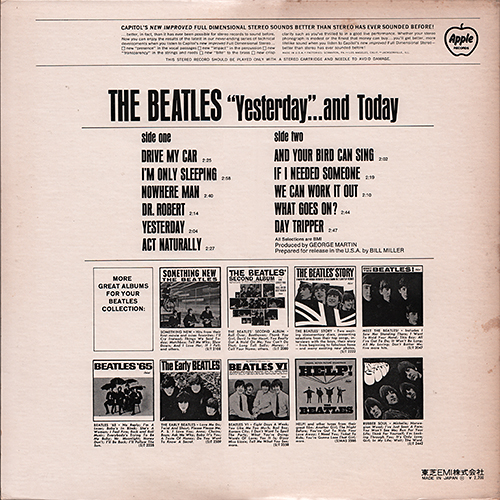 |
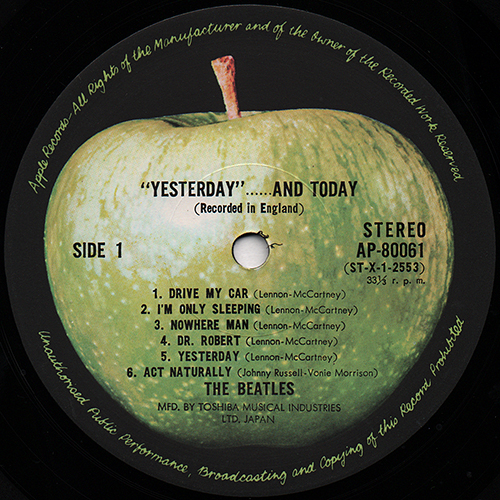 |
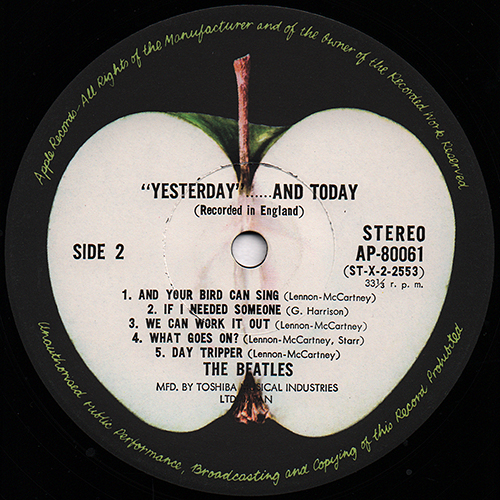 |
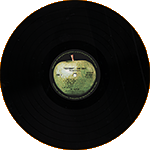 |
|
| INSIDE --> Click! | INSIDE: CLOSE UP |
||||
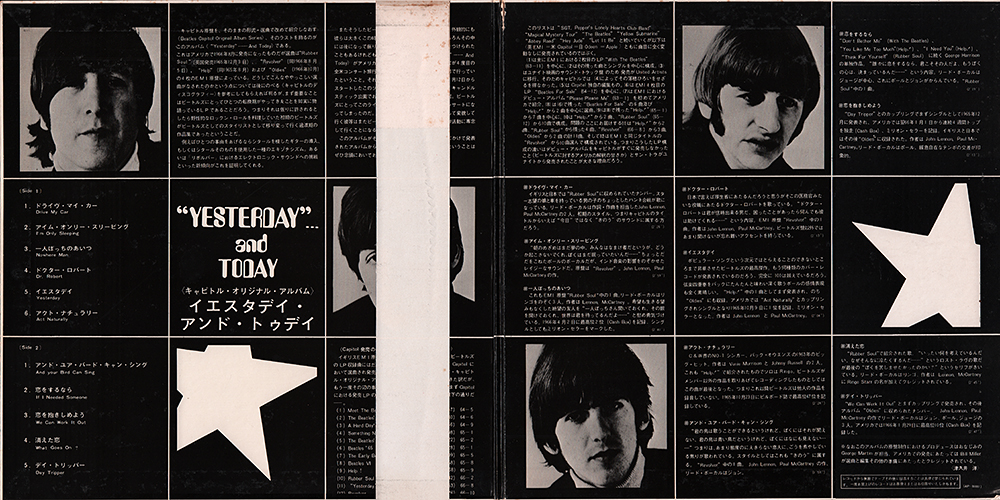 |
Same Trunk cover as U.S. press but with
gatefold jacket. Thick cover. |
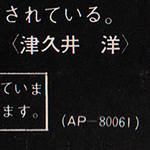 |
Liner notes: Hiroshi
Tsukui. Credited with liner notes on Japanese releases. |
||
| INNER SLEEVE | LYRIC SHEET (Slip Sheet Type) | ||||
| FRONT --> Click! | BACK --> Click! | FRONT --> Click! | BACK --> Click! | With
Apple
custom black inner sleeve. The lyric sheet is slip sheet type. |
|
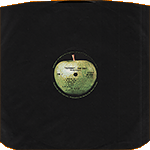 |
 |
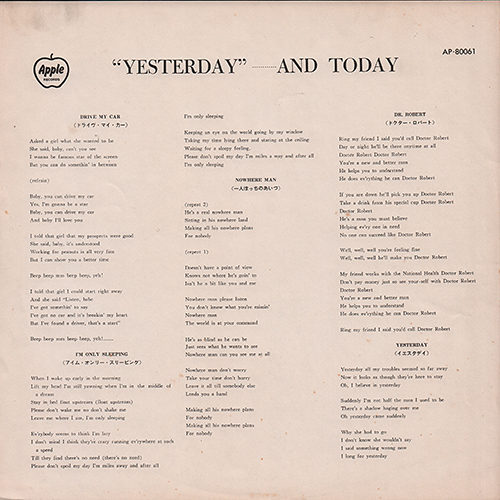 |
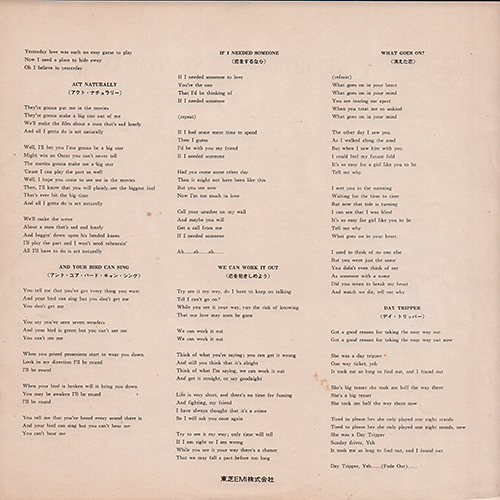 |
||
| LYRIC
SHEET CLOSE UP |
|||||
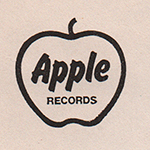 |
Apple logomark was printed at the upper left corner of the lyric sheet. |  |
 |
||
| Catalog No. and the company name "Toshiba EMI Ltd." were printed on the lyric sheet. | |||||
| FRONT COVER CLOSE UP | BACK COVER CLOSE UP | ||||
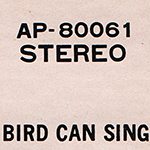 |
Catalogue number and "STEREO" were printed at the upper right corner of the front cover. | 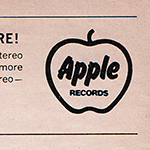 |
 |
||
| Apple logomark was printed at the upper right
corner of the back cover. "Toshiba EMI Ltd." and "H ¥2,000" were printed at the bottom of the back cover. |
|||||
| BACK COVER CLOSE UP | |||||
 |
Capitol executive Dave Dexter Jr. was tabulated the choice and running order of the songs contained on all of the previous make-shift American Beatles albums, however, the project was turned over to another Capitol employee, Bill Miller, who ended up being credited on the album jacket. | ||||
| Apple Gourd in White OBI CLOSE UP | |||||
| OBI: FRONT | OBI: BACK | ||||
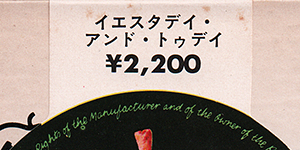 |
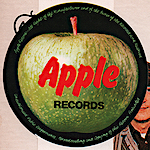 |
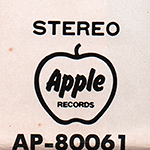 |
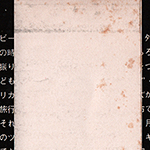 |
||
| Issued with a narrow Obi with a large round Apple logo at the top, has a white background. The word "STEREO" and Apple logo mark and catalog number "AP-80061" were printed on the front. 1st. pressing had a priced ¥2,200 on the obi strip. | The order form was NOT printed on the obi. | ||||
| LABEL CLOSE UP | |||||
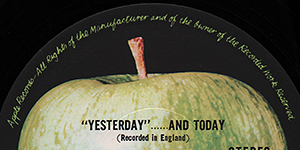 |
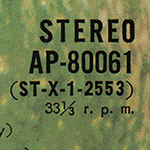 |
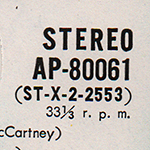 |
The phrase "Apple Records - All Rights of the Manufacturer and of the Owner of the Recorded work Reserved." was printed at the perimeter. "AP-80061" and matrix number were printed at the right side of the center hole. | ||
| LABEL CLOSE UP | |||||
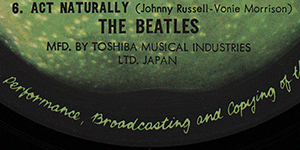 |
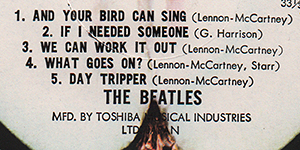 |
The words "MFD. BY TOSHIBA MUSICAL INDUSTRIES LTD. JAPAN" was printed at thebottom of the label. | |||
|
OTHER ITEM
|
|||||
| - | |||||
| RECORD LABEL | Dark Green Apple label Type-2-1 |
||||
| MIX | STEREO |
||||
| MATRIX No. | SIDE 1 | ST-X-1-2533 1S2 10 | |||
| SIDE 2 | ST-X-2-2533 1S2 9 | ||||
| PRESS MARK | 4-1W |
||||
| VINYL COLOR | BLACK |
||||
| RECORD COMPANY'S NAME | SLEEVE | Toshiba EMI Kabusikigaisha |
|||
| LABEL | MFD. BY
TOSHIBA MUSICAL INDUSTRIES LTD. JAPAN |
||||
| SYMBOL/PRICE | H ¥2,200 |
||||
| LYRIC SHEET STYLE | Slip Sheet Type |
||||
| COVER FORM | Gatefold Type. Thick cover. | ||||
| INNER SLEEVE |
Apple custom black sleeve |
||||
| OBI |
"Gourd" in white Obi (a narrow Obi with a large round Apple logo at the top) / without Order sheet | ||||
| COVER DESIGN/ PHOTO/ NOTES | Photo: Robert Whitaker Liner notes: Hiroshi Tsukui. |
||||
|
COMMENTS
|
"Beatles Capitol
Original Album (AP-800XX)" is a series that introduces
American Capitol edited albums in the same format and songs
as at the time. Seven albums from "Meet The Beatles! (AP-80011)" to "Yesterday And Today (AP-80061)" were released in 1970. Light green Apple label Type-2-1with black print. Same Trunk cover as USA but with gatefold jacket. Songs are from U.K. master tapes, different than USA pressings. In Novemver 1968, that was the date when Apple Corp Ltd. of England and Toshiba came to an agreement on the manufacturing and distribution of the Beatles' records in Japan. As part of that agreement, Toshiba had to reissue on the Apple label all the records previously issued on the Odeon label.The sleeves also had to be altered to desplay the Apple logo. Futher still, all the Odeon catalog number prefixes were changed to ones With Apple prefixes.In most cases, only the prefixes were changed and the catalog numbers were left intanct.Odeon singles, EPs, and LPs with the OR or OP prefixes were changed to Apple singles, EPs, and LPs with the AR or AP prefixes , respectively. But Toshiba did not instantly implement all these changes and did not immediately withdraw all Odeon label records.In fact, the phasing out of the Odeon label products and the phasing in of the Apple label was a lengthy process taking several months at least. And in the Apple label, there are two subtypes, TOSHIBA MUSIC and TOSHIBA EMI. Further more, the early copies of the APPLE-TOSHIBA MUSIC type have dark Apple on its label, though the late copies have light one. The obi: Apple "Gourd" in white Obi 1st. pressing issued with a narrow Obi with a large round Apple logo at the top, has a white background. The word "STEREO" and Apple logo mark and catalog number "AP-8940" were printed on the front. later pressing had a priced ¥2,200 on rear sleeve and obi strip. While most Japanese records feature local music, a lot of music fans there like foreign music, as well. The language barrier in Japan presented a problem – should foreign album covers be changed for Japanese albums? The solution was the obi, which means “belt” or “sash”. The obi is a strip of paper, usually about two inches wide, that wraps vertically around the album cover, containing information about the artist and album in Japanese. As these strips of paper were fragile and easily torn, they are often missing, especially since consumers in the 1950s and 1960s attached little significance to them. Finding Japanese records made prior to 1970 that still have the obi intact can be quite difficult, and for some albums, nearly impossible. The inclusion of the obi can dramatically affect the price of some Japanese records, sometimes increasing the price by a factor of ten. |
||||
